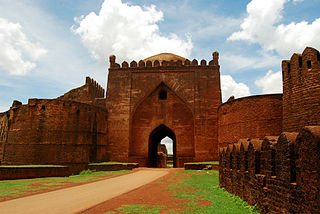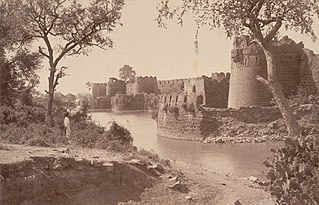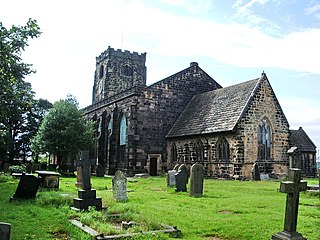| Jama Masjid, Bidar | |
|---|---|
 | |
| Religion | |
| Affiliation | Islam |
Jama Masjid is a congregational mosque in Bidar. [1]
| Jama Masjid, Bidar | |
|---|---|
 | |
| Religion | |
| Affiliation | Islam |
Jama Masjid is a congregational mosque in Bidar. [1]
From the style of its construction, it can be attributed to the late Bahmani period. [1]

The facade has seven arched entrances opening into the courtyard. The middle arch, with a span of 17 feet, is slightly larger than the others, which have a span of 16 feet two inches.
It is topped by a dome, which rests upon an octagonal base. Each side of the base has a length of 12 feet, and the height of the base is 10 feet 6 inches above the roof. A trefoil-patterned parapet runs along the length of the roof. [1]

The Hunsecker's Mill Covered Bridge is a covered bridge located in Lancaster County, Pennsylvania, United States. The bridge has a single span, wooden, double Burr arch trusses design. The bridge, which spans the Conestoga River, is 180 feet (55 m) long, making it the longest single span covered bridge in the county.

The Landis Mill Covered Bridge is a covered bridge that spans the Little Conestoga Creek in Lancaster County, Pennsylvania, United States. A county-owned and maintained bridge, its official designation is the Little Conestoga #1 Bridge. The bridge, built in 1873 by Elias McMellen, is today surrounded by a development, shopping center, and highways on the boundary of Lancaster, Pennsylvania. At 53 feet (16 m), it is the shortest covered bridge in the county.

The Mercer's Mill Covered Bridge or Mercer's Ford Covered Bridge is a covered bridge that spans the East branch of the Octoraro Creek on the border between Lancaster County and Chester County in Pennsylvania, United States. A Lancaster County-owned and maintained bridge, its official designation is the East Octoraro #2 Bridge.

The Neff's Mill Covered Bridge or Bowman's Mill Covered Bridge is a covered bridge that spans the Pequea Creek on the border between West Lampeter Township and Strasburg Township in Lancaster County, Pennsylvania, United States. A county-owned and maintained bridge, its official designation is the Pequea #7 Bridge.

The Pinetown Bushong's Mill Covered Bridge is a covered bridge that spans the Conestoga River in Lancaster County, Pennsylvania, United States. A county-owned and maintained bridge, its official designation is the Big Conestoga #6 Bridge. The bridge is also known as Pinetown Covered Bridge, Nolte's Point Mill Bridge and Bushong's Mill Bridge.

The Zook's Mill Covered Bridge is a covered bridge that spans Cocalico Creek in Lancaster County, Pennsylvania, United States. A county-owned and maintained bridge, its official designation is the Cocalico #7 Bridge. The bridge is also known as Wenger Covered Bridge or Rose Hill Covered Bridge. It is located west of Brownstown on T 797, near the Warwick and West Earl Townships.

The Goodwill Bridge is a pedestrian and cyclist bridge which spans the Brisbane River in Brisbane, Queensland, Australia. The bridge connects the South Bank Parklands in South Brisbane to Gardens Point in the Brisbane CBD.

A hammerbeam roof is a decorative, open timber roof truss typical of English Gothic architecture and has been called "the most spectacular endeavour of the English Medieval carpenter". They are traditionally timber framed, using short beams projecting from the wall on which the rafters land, essentially a tie beam which has the middle cut out. These short beams are called hammer-beams and give this truss its name. A hammerbeam roof can have a single, double or false hammerbeam truss.
Humnabad is a city and municipal council in the Bidar District of the Indian state of Karnataka. Humnabad is the headquarters of Humnabad taluk.It is famous for The Veerabhadreswar Temple.It is at the center of Bidar and Kalaburgi District.It is at a distance of 60km from both the districts.It is well connected by roadways and railway network.It is connected by two national Highways NH-50 & NH-65.

Bocking Windmill or Bocking Churchstreet Windmill is a grade I listed post mill at Bocking, Essex, England which has been restored.

Bidar Fort is located in old city area, Bidar, Karnataka, India. The fort, the city and the district are all affixed with the name Bidar. Sultan Ahmad Shah I of the Bahmanid dynasty shifted his capital from Gulbarga to Bidar in 1427 and built his fort along with a number of Islamic monuments. There are over 30 monuments inside Bidar fort.

The Gulbarga Fort is located in Kalaburagi in the Kalaburagi district of North Karnataka. The fort was originally constructed by the Hindu monarch Raja Gulchand, and it was subsequently significantly enlarged in 1347 by Ala-ud-Din Bahman Shah of the Bahmani Kingdom after he cut off his ties with the Delhi Sultanate. Islamic monuments such as mosques, palaces, tombs, and other structures were also built later within the refurbished fort. The Jama Masjid, built later within the fort in 1367, is a unique structure built in the Persian architectural style, fully enclosed with elegant domes and arched columns. It was built to commemorate the establishment of the dynastic rule of the Bahmani Kingdom at Gulbarga Fort between 1347 and 1424. It remained the capital of the Bahmani Kingdom until 1424 where after the capital was shifted to Bidar, which had better climatic conditions.

St Andrew's Church is an Anglican church in Leyland, Lancashire, England. It is an active Anglican parish church in the Diocese of Blackburn and the archdeaconry of Blackburn. The church is recorded in the National Heritage List for England as a designated Grade II* listed building.

The Cala Galdana Bridge is a steel arch bridge over Algendar Creek on the island of Menorca, Spain. It is the first vehicular bridge constructed in duplex stainless steel.

The Diwan-i-Am, or Hall of Audience, is a building in the Red Fort of Delhi where the Mughal emperor Shah Jahan (1592–1666) and his successors received members of the general public and heard their grievances.

The Stone Arch Bridge is a stone arch railroad bridge in Keene, New Hampshire, United States. Built in 1847 to carry the Cheshire Railroad, it is one of the best-preserved pre-1850 stone arch bridges in the nation. The bridge was listed on the National Register of Historic Places in 2012, and the New Hampshire State Register of Historic Places in 2006. It now carries a multi-purpose rail trail.

The Madrasa of Mahmud Gawan is a madrasa or Islamic college in Bidar, Karnataka, India. It was built in the 1460s and is an example of the regional style of Indo-Islamic architecture under the Bahmani Sultanate. This heritage structure is placed under the list of monuments of national importance. Founded by the prime-minister of the sultanate in the late 15th century, it bears testimony to the scholarly genius of Mahmud Gawan, who first came to Delhi as a Persian trader from Gilan in Iran and moved to Bidar in 1453.

Kali Masjid is a mosque in the town of Bidar, in the Indian state of Karnataka.

Chaubara, also spelt Choubara, is a historic watchtower located in Bidar, in the Indian state of Karnataka. It is listed as a state protected monument.

Solah Khamba Mosque is a building within the Bidar Fort in Bidar, in the Indian state of Karnataka.